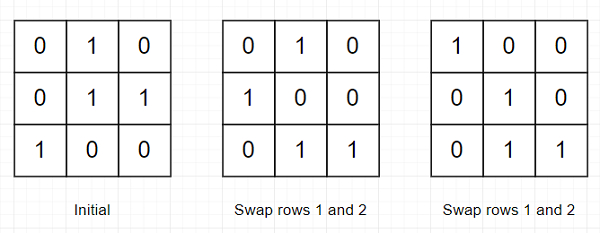
 Data Structure
Data Structure Networking
Networking RDBMS
RDBMS Operating System
Operating System Java
Java MS Excel
MS Excel iOS
iOS HTML
HTML CSS
CSS Android
Android Python
Python C Programming
C Programming C++
C++ C#
C# MongoDB
MongoDB MySQL
MySQL Javascript
Javascript PHP
PHP
- Selected Reading
- UPSC IAS Exams Notes
- Developer's Best Practices
- Questions and Answers
- Effective Resume Writing
- HR Interview Questions
- Computer Glossary
- Who is Who
Program to find minimum swaps to arrange a binary grid using Python
Suppose we have a n x n binary matrix. We can perform an operation on it like, at one step we select two adjacent rows and swap them. We have to count number of minimum swaps required, so that all nodes above the major diagonal of the matrix is 0. If there is no such solution, then return -1.
So, if the input is like
| 0 | 1 | 0 |
| 0 | 1 | 1 |
| 1 | 0 | 0 |
then the output will be 2 because −

To solve this, we will follow these steps:
n := row count of matrix
m := make an array of size n and fill with n
-
for i in range 0 to n - 1, do
-
for j in range n-1 to 0, decrease by 1, do
-
if matrix[i, j] is same as 1, then
m[i] := n-j-1
come out from the loop
-
-
t := 0, ans := 0
-
for i in range 0 to n - 1, do
t := t + 1
flag := False
-
for j in range i to n - 1, do
-
if m[j] >= n-t, then
ans := ans + j-i
flag := True
come out from loop
-
-
if flag is false, then
return -1
update m[from index i+1 to j] by m[from index i to j-1]
return ans
Let us see the following implementation to get better understanding −
Example
def solve(matrix): n = len(matrix) m = [n] * n for i in range(n): for j in range(n-1,-1,-1): if matrix[i][j] == 1: m[i] = n-j-1 break t,ans = 0,0 for i in range(n): t += 1 flag = False for j in range(i,n): if m[j] >= n-t: ans += j-i flag = True break if not flag: return -1 m[i+1:j+1] = m[i:j] return ans matrix = [[0,1,0],[0,1,1],[1,0,0]] print(solve(matrix))
Input
[[0,1,0],[0,1,1],[1,0,0]]
Output
2

